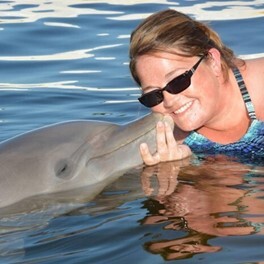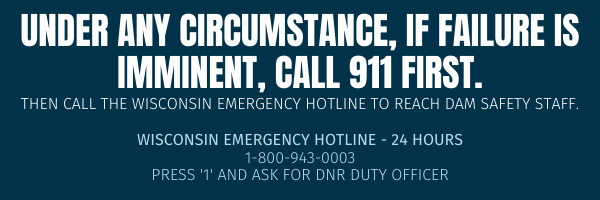|
Dec. 11, 2023
The Wisconsin Department of Natural Resources (DNR)'s Dam Safety and Floodplain Program has had several personnel changes in the past year that we want to share.
Regional Water Management Engineers
We have had to say goodbye to our Regional Water Management Engineers, Mike Rogney, Mike Stone and Megan Duffy. Mike Rogney and Megan Duffy have moved to other agencies, and Mike Stone has moved to another DNR program. We are fortunate they shared their talents with our program, and we will certainly miss them. We wish them the best in their new endeavors.
We are currently recruiting for their vacant positions.
Who Do You Call?
Due to the aforementioned vacancies, Water Management Engineer county coverage has evolved to better balance workloads and access to water management engineers across the state. Should you need to contact a regional Water Management Engineer, a list of county coverage contacts is available online. We encourage you to keep it handy, as it will be updated again in the next several months.
Floodplain Management Program Coordinator
Brian Cunningham has been part of the Waterways Program since 2020, working as the Floodplain Management Program Coordinator. Brian recently accepted the position of Waterways Southwest Regional Field Supervisor. In this new role, Brian will manage the Waterways regulatory programs in the southwest part of the state, including Chapter 30 (waterways), Chapter 31 (dams), wetland permitting, floodplain/shoreland zoning program oversight and compliance. We are thrilled that Brian is continuing to work in our program!

Please help us welcome Sarah Rafajko as our new statewide Floodplain Management Program Coordinator! The Floodplain Management Program Coordinator is responsible for working with local governments to assist them in meeting the National Flood Insurance Program (NFIP) requirements through a program of education, technical assistance and oversight. Sarah started on Sept. 11 and works out of the La Crosse office. She can be reached at Sarah.Rafajko@wisconsin.gov and 608-893-8710.
Sarah shares the following:
"Hello everyone! I'm really excited to be stepping into this new role and look forward to working with all of you. I was the Floodplain Manager for the city of La Crosse, where I was responsible for education/outreach, enforcement, remediation and hazard mitigation in a community with over 2000 structures in the floodplain.
My background in Floodplain Management began while managing construction projects as part of the Master Plan for the Dolphin Research Center in the Florida Keys. There, I learned the private side of permitting commercial work in V and AE zones. I developed a love for marine mammals, engaging with the dolphins and sea lions at every opportunity and participated on the only authorized Manatee Rescue Team in the Florida Keys.
An opportunity to work in Code Enforcement with Monroe County, FL, came along, where I spent the bulk of my time performing damage assessments after Hurricane Irma, a category four storm that left 1761 homes substantially damaged, including the house I was renting.
Due to the significant rise in housing costs after the hurricane, I decided it was financially unsustainable and moved back to Wisconsin to be near family. It took a couple of years to get back into the career path I left behind, but things fell into place, and I was able to get back into Code Enforcement and, eventually, Floodplain Management for the city of La Crosse.
Considering what I experienced, floodplain management is quite personal to me, and I aspire to do what I can to prevent the financial, environmental and emotional devastation that comes with flooding. "
|

Floodplain Mapping Program Coordinator
In November 2022, we also said farewell to our Floodplain Mapping Program Coordinator, Betsy Finlay. A big thank you to Betsy for her tenacity and commitment to producing quality floodplain mapping products!
Please help us welcome Emily Szajna as our new Floodplain Mapping Program Manager. Emily has been a valued team member of the Floodplain Mapping program for several years as GIS Project Lead. We are happy to have her stepping into her new role. Emily will manage Wisconsin's floodplain mapping projects funded by FEMA Cooperating Technical Partner (CTP) grants. A significant part of her role is grant administration, dealing with project schedules, budgets and reporting requirements. She will also serve as the Floodplain Mapping Program GIS Technical Lead. Emily's work is vital for local communities as they develop and administer their floodplain ordinances. Knowing where homes and businesses are relative to the various flood zones is critical to having the proper insurance and keeping people and property safe.
Emily is excited about and committed to working collaboratively with local communities and other state and federal agencies to further goals associated with reducing flood risk. She is thankful for the opportunity to share Wisconsin's ideas and concerns with the national floodplain program. FEMA and the Wisconsin DNR want to improve flood risk mapping to provide the best possible data for communities. Emily's involvement will help ensure the best data and access for Wisconsin. When not working on improving the Floodplain Program, Emily is busy hiking, doing puzzles, traveling, camping and reading.
Emily can be reached at Emily.Szajna@wisconsin.gov or 608-422-0365. Interested in learning more about floodplain mapping? More information is available online.
|
|
|
|
Emergencies can happen to any of us at any time and anywhere.
Emergencies can happen while driving, when weather conditions deteriorate, someone gets sick, a fire starts or a structure fails. The scope and complexity of the incidents can vary, but it is common to have communities, jurisdictions and organizations working together to save lives, stabilize incidents and protect property and the environment. The Federal Emergency Management Agency has developed the National Incident Management System, a consistent nationwide template to enable partners to work together consistently to prevent, respond to and recover from incidents regardless of the cause, size, location or complexity.
The National Incident Management System Training Program identifies courses critical to training emergency and incident response personnel on all concepts and principles of each National Incident Management System component.
A general understanding of the Incident Command System may be useful if there is ever an incident at your dam or a widespread flooding event. There are numerous free videos that dam owners and engineering consultants can watch:
-
IS-700: National Incident Management System, An Introduction - This course provides an overview of the National Incident Management System. The National Incident Management System defines the comprehensive approach guiding the whole community - all levels of government, nongovernmental organizations and the private sector - to work together seamlessly to prevent, protect against, mitigate, respond to and recover from the effects of incidents.
-
ICS-100: Introduction To The Incident Command System – This course introduces the Incident Command System and provides the foundation for higher-level training. This course describes the history, features, principles and organizational structure of the Incident Command System. It also explains the relationship between the Incident Command System and the National Incident Management System.
-
ICS-200: ICS Basic Incident Command System For Initial Response – This course reviews the Incident Command System, provides context within the initial response and supports higher-level Incident Command System training. This course provides training and resources for personnel likely to assume a supervisory position within an Incident Command System.
|
|
|
These days, we hear and read about tools and tips we can use to protect ourselves, our families and our businesses from phone scams and cybersecurity threats. These tools and tips are also relevant in dams' day-to-day operation and maintenance.
Last spring, the DNR Dam Safety Program was alerted by a dam owner concerned about a potential phone scam they had received. The sales pitch was that the company would install a hydropower unit for them. In exchange, the owner could make significant money selling power back to the nearby utility, plus a 50% installation tax credit. On the surface, it sounded enticing!
But, after more conversation, the dam owner discovered they would be responsible for all maintenance and upkeep costs, including an unspecified annual inspection fee to the company.
The other 50% installation fee would be in the form of a 25-year loan from the company, and there could be significant penalties if the dam owner didn't maintain specified flows through the generator at all times. The specified flowrate was simply not feasible at the dam location. In addition, the dam owner would also potentially need to go through the FERC licensing process. While researching online, the dam owner could neither find company information nor obtain a valid call-back phone number.
As with other potential phone scams, the same applies to dams. Do not provide confidential information. Doing your research, asking questions, reading the fine print and getting other opinions and input is essential.
Dams have been a national security concern throughout the United States for years. Some dams are part of the national critical infrastructure where incapacitation or destruction could have a debilitating effect on security, national economic security and/or national public health and safety.
Examples could include large hydropower facilities or sources of drinking water.
Although they are on a smaller scale than national critical infrastructure, some dams in Wisconsin have remote monitoring of water levels or computer systems at the dam for gate operation. Even these functions are subject to cybersecurity threats. Best practices such as using a configuration management program, protecting passwords, installing antivirus software and keeping it up to date also apply to dams.
More information on dam cybersecurity is available online.
Stay vigilant and "Be Dam Safe."
|
|
 "Dam Safety News" is published by the Wisconsin DNR's Waterways Bureau. Its purpose is to inform dam owners, operators and others concerned about dam safety issues. Comments or contributions are welcome.
This newsletter is supported by funding through FEMA National Dam Safety Grant No. EMC-2023-GR-05008 as part of the National Dam Safety Program. The contents do not necessarily reflect the views and policies of the Federal government.
|
|
|
|
|